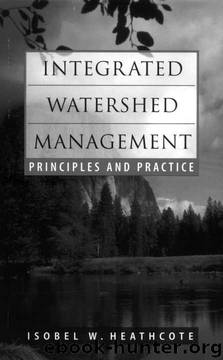Integrated Watershed Management: Principles and Practice by Isobel W. Heathcote

Author:Isobel W. Heathcote
Language: eng
Format: epub
Published: 2009-02-01T14:53:00+00:00
Boundary Setting-Populations A third important element in boundary setting relates to the choice of which species of plants and animals will be included in the analysis. If the analyst is seeking to determine current and future impacts of alternative management actions, the question arises, "Impacts on whom?" It seems to be implicit in most planning initiatives that the species of most, perhaps sole, concern is the human species. But this is by no means always the case. Fish species in particular may form an important part of the analysis, as may macroinvertebrate assemblages (see, for example, the case of watershed planning for the Latrobe River basin, discussed in Section 3.4.2; Grayson et al. 1994).
There are potentially thousands of plant and animal species in an area to be assessed, including not only mammals and birds but insect, amphibian, and reptile species that may be of special interest or value. Domestic animals such as livestock and house pets may also be contributors to, and affected by, water problems in the basin.
The task of setting boundaries on the populations to be assessed may be the most complex and the most controversial of any boundary-setting exercise. Even if there is consensus that the human population is the only one of interest, there may he conflict in regard to which humans are affected, and how. Furthermore, within what appears to be a single user group (for instance, recreational boaters) there may be conflict between Stillwater boaters, such as sailors and canoeists, and users of motor craft. If resources permit, a detailed analysis should include all significant users. If these populations-or, in the case of nonhuman animals and plants, advocates for those populations-are allowed to speak for themselves, the scoping exercise becomes more straightforward. Problems, and conflict, arise when one group, such as agency staff, attempt to make these kinds of scoping decisions without input from the community. The techniques described in Chapter 4 are especially helpful in developing scoping guidelines that are acceptable to all water users.
Download
This site does not store any files on its server. We only index and link to content provided by other sites. Please contact the content providers to delete copyright contents if any and email us, we'll remove relevant links or contents immediately.
| Acoustics | Bridges |
| Earthwork Design | Environmental |
| Fire Science | Highway & Traffic |
| Hydrology | Remote Sensing |
| Seismic Design | Structural |
| Structural Dynamics | Surveying & Photogrammetry |
| Transportation |
Whiskies Galore by Ian Buxton(41704)
Introduction to Aircraft Design (Cambridge Aerospace Series) by John P. Fielding(33009)
Small Unmanned Fixed-wing Aircraft Design by Andrew J. Keane Andras Sobester James P. Scanlan & András Sóbester & James P. Scanlan(32676)
Craft Beer for the Homebrewer by Michael Agnew(18068)
Turbulence by E. J. Noyes(7884)
The Complete Stick Figure Physics Tutorials by Allen Sarah(7253)
Kaplan MCAT General Chemistry Review by Kaplan(6806)
The Thirst by Nesbo Jo(6744)
Bad Blood by John Carreyrou(6464)
Modelling of Convective Heat and Mass Transfer in Rotating Flows by Igor V. Shevchuk(6345)
Learning SQL by Alan Beaulieu(6149)
Weapons of Math Destruction by Cathy O'Neil(6069)
Man-made Catastrophes and Risk Information Concealment by Dmitry Chernov & Didier Sornette(5862)
Digital Minimalism by Cal Newport;(5570)
Life 3.0: Being Human in the Age of Artificial Intelligence by Tegmark Max(5391)
iGen by Jean M. Twenge(5290)
Secrets of Antigravity Propulsion: Tesla, UFOs, and Classified Aerospace Technology by Ph.D. Paul A. Laviolette(5229)
Design of Trajectory Optimization Approach for Space Maneuver Vehicle Skip Entry Problems by Runqi Chai & Al Savvaris & Antonios Tsourdos & Senchun Chai(4946)
Electronic Devices & Circuits by Jacob Millman & Christos C. Halkias(4857)
